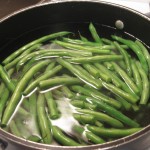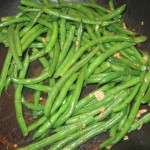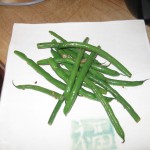 Native to South or Central America, string beans did not appear in Europe until the Age of Exploration. String beans are very similar to dried beans but are harvested earlier in the growing cycle, meaning that the seeds (beans) are immature and the pod is still tender. String beans are sometimes called “snap” or “green” beans, even though they appear in several different colors. Early varieties of the string bean had a tough, string-like fiber running along their pods, hence the name. In the late 1800s, American growers developed the string-free beans that we know today. Green, yellow, and purple varieties are common. Some types are “bush” beans, which have short, sturdy vines, and others are “pole” beans, meaning they climb upwards. Today, beans are one of the most common vegetables in the country.
Native to South or Central America, string beans did not appear in Europe until the Age of Exploration. String beans are very similar to dried beans but are harvested earlier in the growing cycle, meaning that the seeds (beans) are immature and the pod is still tender. String beans are sometimes called “snap” or “green” beans, even though they appear in several different colors. Early varieties of the string bean had a tough, string-like fiber running along their pods, hence the name. In the late 1800s, American growers developed the string-free beans that we know today. Green, yellow, and purple varieties are common. Some types are “bush” beans, which have short, sturdy vines, and others are “pole” beans, meaning they climb upwards. Today, beans are one of the most common vegetables in the country.
Growing Tips
Beans are tender and cold-sensitive, meaning that you should not plant them until frost is no longer a threat. Transplanting is not recommended for beans; instead sow the seeds directly. Beans should be planted in sunny, warm, well-drained soil to reduce the risk of rotting. If planting pole beans, you will need to construct a trellis or teepee for the vines to climb. Bean teepees are a fun garden project for kids and can be made with just a few sticks and/or string. For a steady supply of beans, sow seeds every 3 weeks and pick often. If oversized beans stay on the vine, production will slow, so be sure to pick off old beans even if you do not intend to eat them. Try to pick beans in dry weather to prevent the spread of disease among plants.
Storage
It is best to use string beans as soon as possible after picking, but they will keep well in the refrigerator for several days if loosely wrapped in a plastic bag. Do not wash or cut the beans until you are ready to use them.
Nutritional Benefits
Beans, technically legumes and not vegetables, are rich in protein. String beans are high in vitamins A, B-1 (thiamin), and B-2 (riboflavin), calcium, and potassium. They also contain significant quantities of iron, which is vital to read blood cell health.
Preparation
Rinse beans. Snap the stem-like ends off the beans with your fingers (snapping rather than cutting prevents breaking the inner beans, but cutting will also work). Beans can be simply steamed or incorporated into a variety of recipes. To freeze: snap or cut beans into desired lengths. Steam 2-3 minutes, drain, chill, and pack into freezer bags. When you are ready to use the beans, remember that they are already partially cooked!
Recipe: Garlicky Green Beans
Susan Leclair, a volunteer baking, tasting and testing recipes out of the Vermont Fresh Guide tried out this Garlicky Green Beans recipe. She said, “It took me 20 minutes from start to finish, cost $3.32 and the portion is good for 4 . The last picture is what I would consider a portion size. The taste has good acid with the lemon and nice bite of the garlic. I used olive oil but I think that butter would add more flavor!!”
Serves 4
Ingredients
- 1 pound green (string) beans
- 1 tablespoon olive oil or butter
- 4 cloves of garlic, finely chopped
- 1 tablespoon lemon juice
- Salt and pepper
Instructions
- Bring a saucepan of water to a boil.
- Wash beans and snap off stem ends. Throw beans into boiling water and cook until tender, about 5 minutes. When beans are done, drain in colander and allow to steam dry.
- Heat oil or butter in saucepan and sauté garlic. When garlic begins to brown, add the lemon juice.
- Remove pan from heat and return beans to pan, tossing gently. Add salt and pepper to taste. Serve hot.
Note: For a tasty variation of this recipe, try adding 1 cup of grated cheddar or Parmesan cheese and a ¼ cup of white wine during step 3 to make a cheesy sauce.
- Photo courtesy of Susan Leclair
- Photo courtesy of Susan Leclair
- Photo courtesy of Susan Leclair
- Photo courtesy of Susan Leclair
Recipe: Easy String Bean Casserole
Serves 6
(adapted from Diana Rattray: about.com)
Ingredients
- 1 can condensed cream of mushroom soup
- 1 cup milk
- ¼ teaspoon pepper
- 1 pound string beans, trimmed and chopped, OR 2 cans string beans, drained
- 1 ½ cups fried onions or crumbs of buttery crackers, such as Ritz
Instructions
- Preheat oven to 350°.
- Mix soup, milk, and pepper together in a 1 ½ quart casserole dish.
- Stir in beans and ⅔ cup fried onions or cracker crumbs.
- Bake for 30 minutes, stirring once. Top with remaining onions or crumbs and bake 5-10 minutes longer, until top is golden. Serve warm.
To receive more recipes and tips on your favorite fruits and vegetables, download the Vermont Fresh: A Fruit and Vegetable Handbook.
We’re looking for more volunteers to test recipes and give us feedback on preparation time, cost and, of course, taste!




